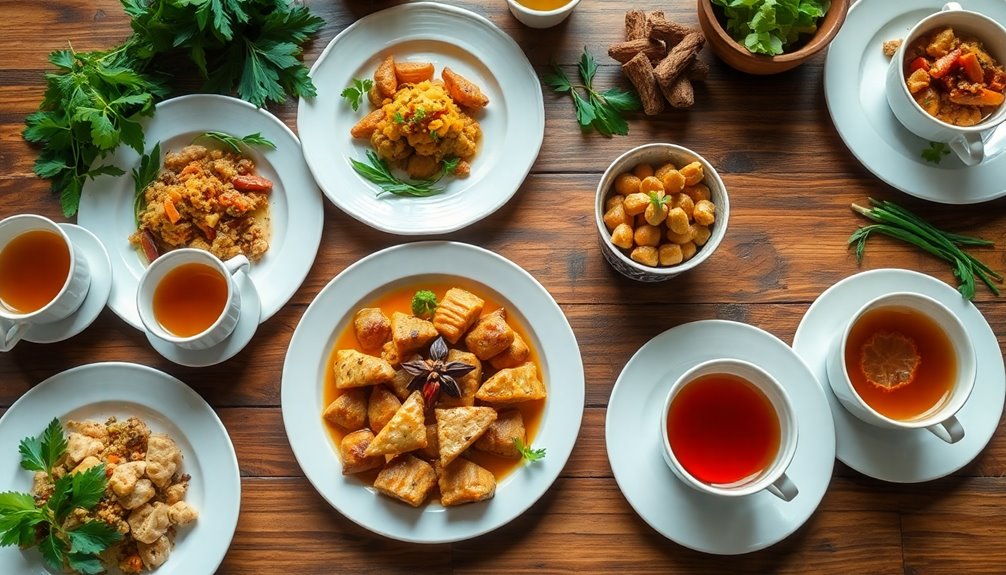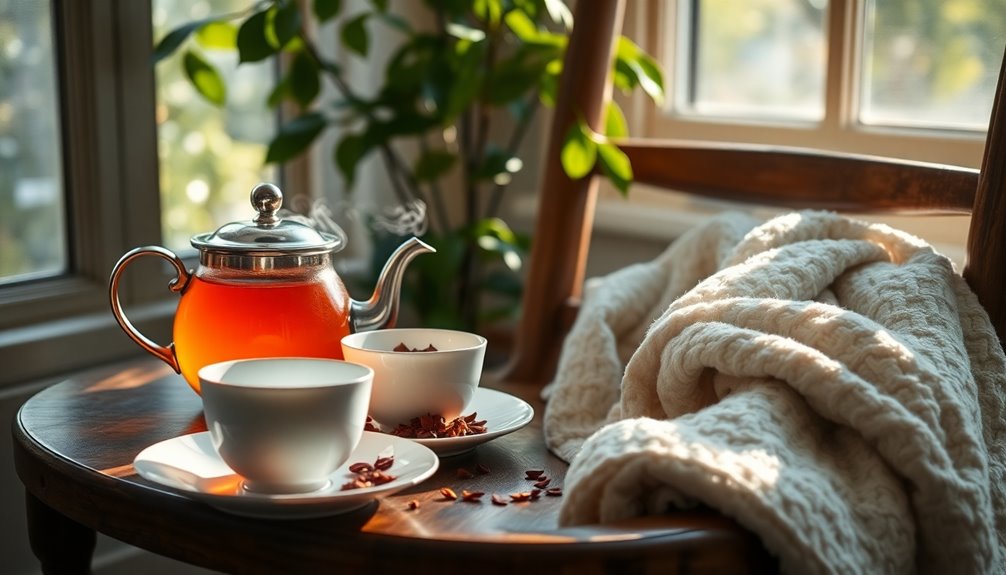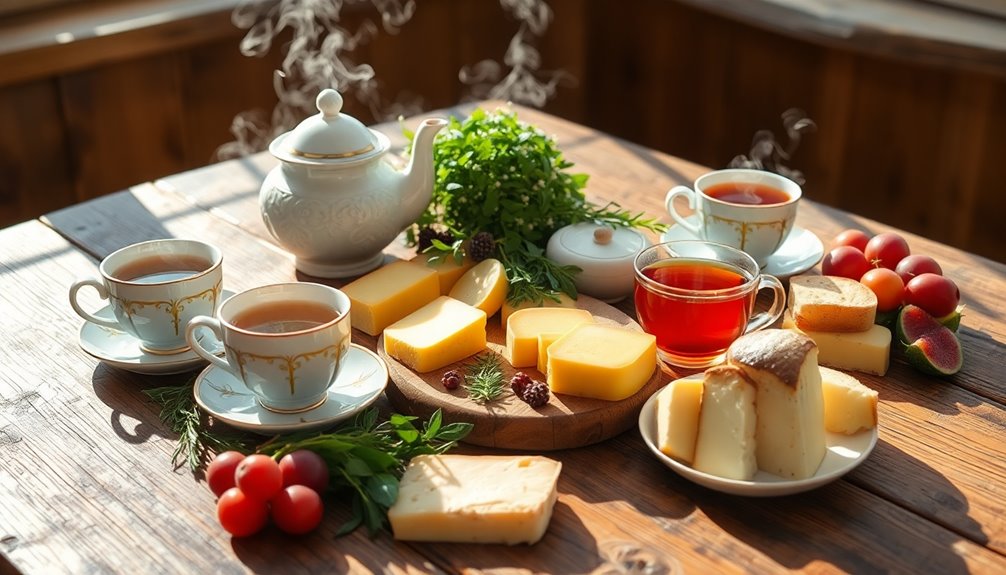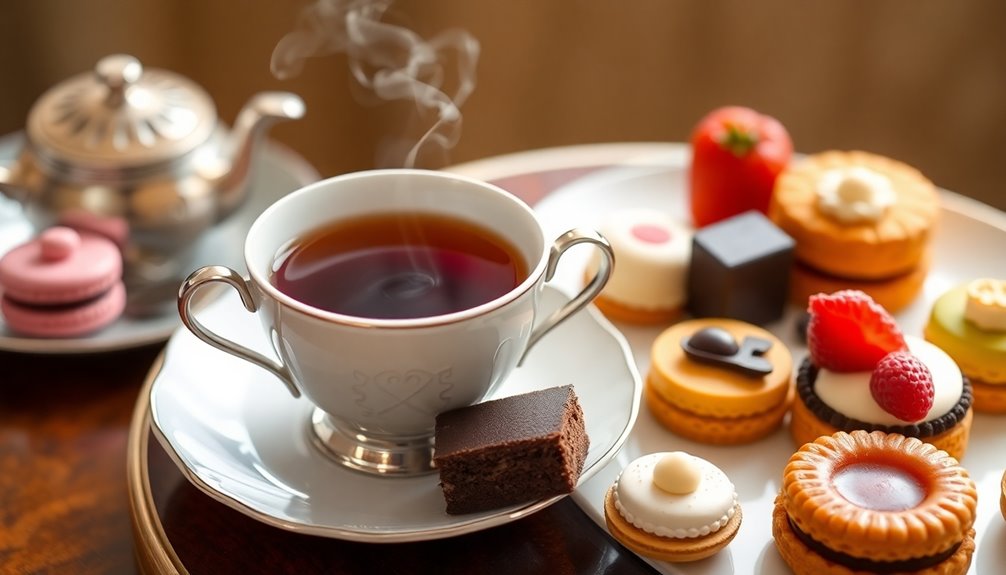To pair tea with savory dishes like a pro, start by considering the flavors of both your food and tea. For rich dishes, robust black teas like Assam can enhance umami, while lighter teas such as Jasmine Green work well with spices. Oolong is great for balancing grilled meats, and delicate white teas brighten salads. Don't hesitate to experiment! Try different combinations, drawing inspiration from various cultures for unique pairings. This exploration can lead to delightful culinary experiences that elevate your meals. There's plenty more to discover about how tea can elevate your dining experience.
Key Takeaways
- Start with lighter teas for delicate savory dishes, gradually moving to robust options for richer meals to enhance flavor balance.
- Consider the flavor profiles of both the tea and the dish to create complementary or contrasting pairings for an optimal experience.
- Use specific teas, like oolong with umami-rich foods or Earl Grey with smoky dishes, to elevate the overall taste.
- Experiment with brewed tea in marinades or sauces to infuse dishes with complex flavors that harmonize with your meal.
- Draw inspiration from cultural traditions, such as Japanese kaiseki or Indian chai, for unique and enjoyable tea pairings with savory foods.
Introduction
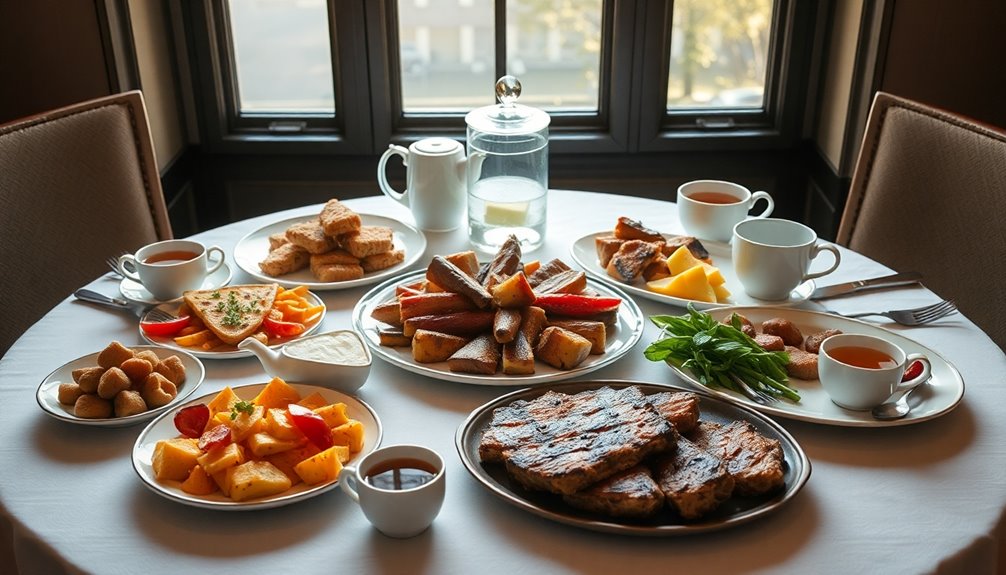
When it comes to enhancing your dining experience, pairing tea with savory dishes can make a remarkable difference. Just like traditional wine pairings, tea and food pairings can elevate your meals by complementing or contrasting flavors.
For instance, Jasmine Green Tea works beautifully with curried chicken, adding a floral note that balances the spice. If you're enjoying a smoky grilled dish, consider a robust Earl Grey; its bergamot notes can cut through the richness, creating a harmonious tasting experience.
Light teas, such as green tea, are perfect for delicate seafood or salads, while oolong teas shine with grilled meats and sautéed vegetables due to their earthy flavor. Butter's creamy texture can enhance the richness of dishes paired with oolong tea, creating a delightful balance. Additionally, the antioxidants found in green tea may contribute to heart health, further enhancing your meal experience. The rich antioxidants in yerba mate can also complement savory dishes, adding a unique flavor profile to your meal. Furthermore, incorporating natural elements such as fresh herbs can elevate the overall flavor of your dish when paired with tea.
The versatility of oolong allows it to adapt well to various savory dishes, making it a great choice for experimentation. Don't hesitate to try different combinations; the world of tea pairing is vast and rewarding. Drinking tea has also been linked to lower rates of depression, which can enhance your overall dining experience.
You might uncover delightful flavor profiles that surprise you. So, dive into the culinary exploration of tea and food pairings, and let your palate guide you on this exciting journey!
Culinary Traditions and Tea Pairings
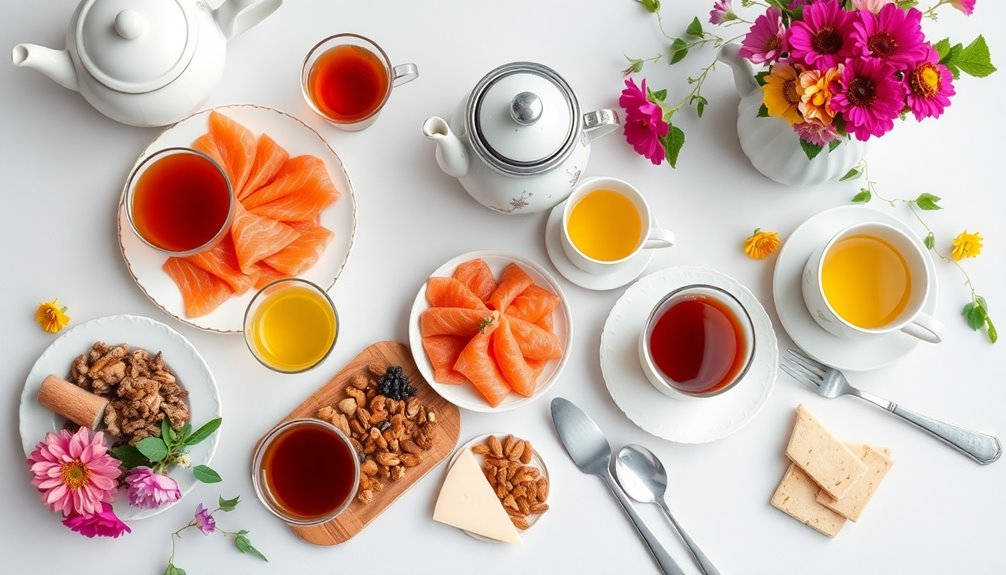
Throughout history, various culinary traditions have seamlessly integrated tea into their dining experiences, enhancing the flavors of savory dishes. For instance, Japanese kaiseki meals elegantly pair delicate teas with multi-course offerings, showcasing an artful balance. The use of essential oils in culinary settings can further elevate flavors and create a positive environment, enhancing the overall dining experience. Additionally, the optimal steeping time for different teas plays a crucial role in achieving the best flavor profiles when pairing with food. Using essential oils like lemon can add a refreshing twist to dishes, enhancing mood improvement during meals. Incorporating eucalyptus oil into culinary creations can also provide a unique flavor dimension while supporting overall health.
In Victorian England, high tea evolved to include savory items like cheeses and meat pies, illustrating a sophisticated approach to tea pairings that emphasizes flavor enhancement. Russian tea service traditions further highlight tea's versatility, as it complements hearty, savory foods, proving that tea can harmonize with rich flavors.
Similarly, in Chinese cuisine, specific teas like Jasmine Green Tea are paired with curried chicken, demonstrating the cultural practice of matching tea types to regional dishes for an optimal taste experience. Regular use of essential oils in culinary settings can create a positive environment, enhancing the overall dining experience.
As culinary traditions continue to fuse, innovative pairings emerge. For example, gravlax canapés with matcha cream cheese blend global influences to create unique and harmonious tea and food combinations.
Tea Enhances Umami Flavors
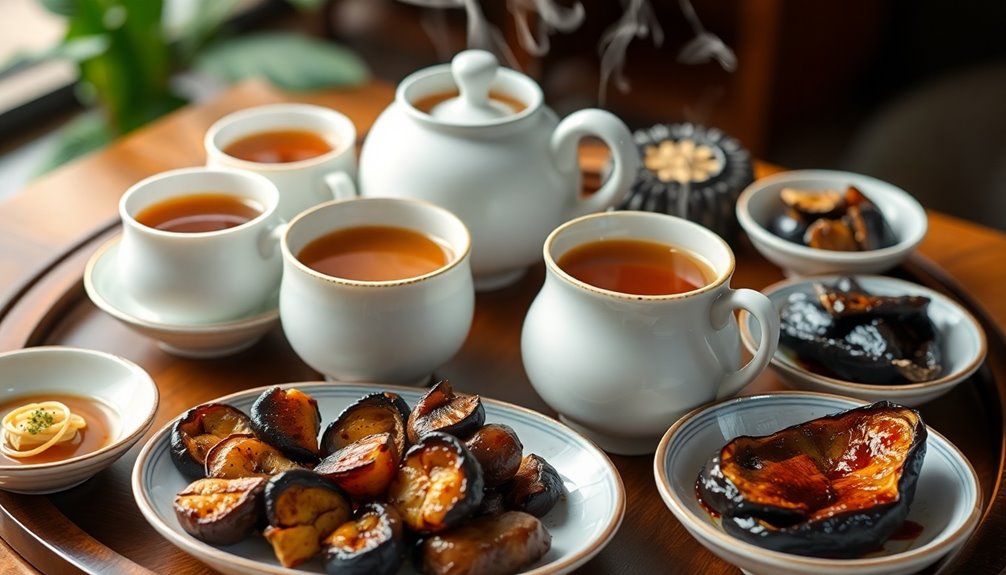
Tea enhances umami flavors in savory dishes, bringing out their rich and complex profiles. To truly elevate your culinary experience, consider incorporating oolong teas, which are known for their earthy notes. These teas beautifully complement umami-rich foods like mushrooms, soy sauce, and ripe tomatoes, enhancing the overall flavor of your dish. Additionally, caffeine content in oolong tea can vary, allowing for different experiences depending on the brewing method. Chia seeds, which are high in omega-3 fatty acids, can also be a great addition to meals that pair well with tea, providing extra nutritional benefits. Furthermore, the use of traditional techniques in crafting Indonesian decor masks showcases the artistry and cultural significance that can inspire culinary presentations.
Oolong tea is also rich in antioxidants, which contribute to overall health and well-being.
Opt for dark oolongs when serving roasted vegetables or grilled meats; their rich flavors harmonize perfectly with umami characteristics.
If you're indulging in aged cheeses or cured meats, try pairing them with pu-erh tea. This combination not only creates a balanced taste but also deepens the richness of the experience.
For seafood lovers, smoky green teas can work wonders. They amplify umami in grilled or sautéed fish, making each bite a delightful match.
The unique fermentation process of certain teas, especially aged oolong, produces compounds that can mimic umami flavors, adding a satisfying dimension to savory dishes. Additionally, the traditional tea ceremony highlights the importance of mindful pairing and appreciation of flavors, enhancing your overall dining experience.
Tea's Role in Umami Balance
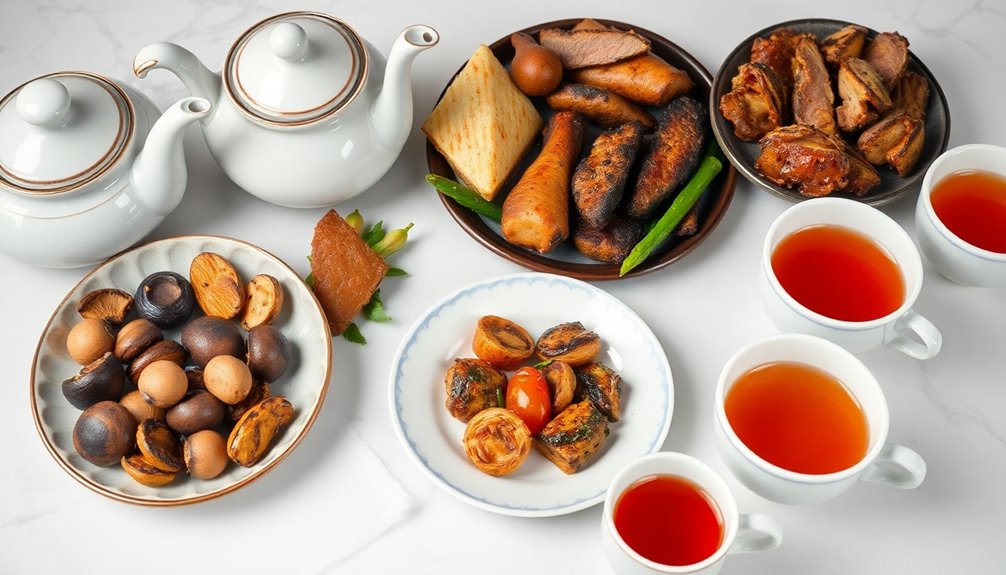
In pairing savory dishes, understanding how to balance umami is crucial for a satisfying meal. The right tea can enhance the umami flavors in your food, making it more enjoyable. For grilled meats, robust black teas like Assam work wonders. Their depth and complexity elevate the umami profile, complementing the savory characteristics of the dish. Additionally, it's important to consider the interest rate impact on your overall budget when planning meals that incorporate specialty ingredients. Freshly brewed tea, like fresh lemon juice, can also provide a zesty touch that complements savory flavors. Regular maintenance of your cooking equipment, such as stovepipe cleaning, is also essential for a safe cooking environment.
If you're serving umami-rich foods like grilled fish or stir-fried vegetables, consider using green tea. Its natural astringency provides a refreshing contrast to the richness, creating a balanced dining experience.
For heartier options like savory stews or creamy soups, dark oolongs and black teas can add layers of flavor and depth.
You can also experiment with brewing techniques to maximize umami extraction. Higher temperatures for black tea or longer steeping times for oolong can intensify the pairing.
Additionally, think about incorporating tea as a cooking ingredient. Using brewed tea in marinades or poaching liquids infuses your dishes with rich, complex flavors that enhance their umami characteristics. This approach aligns with the Law of Attraction principle of manifesting positive outcomes through intentional choices, demonstrating how mindful pairings can elevate your culinary experiences.
Cultural Tea Pairing Differences

Pairing tea with savory dishes varies significantly across cultures, each bringing unique traditions and flavors to the table.
In Japanese cuisine, for example, you'll find that green tea, especially matcha, pairs well with sushi and sashimi. It enhances umami flavors while aiding digestion. Additionally, the concept of umami flavors is deeply rooted in various culinary traditions, including Brazilian dishes that incorporate native ingredients. In Southern cuisine, dishes like fried catfish can also benefit from the refreshing qualities of green tea.
Meanwhile, in British culture, afternoon tea showcases savory options like cucumber sandwiches and smoked salmon, often enjoyed with lighter black teas like Earl Grey or Darjeeling.
Chinese cuisine frequently uses oolong and pu-erh tea leaves alongside rich savory dishes. These teas cut through oiliness and complement flavors in stir-fries and braised meats.
If you explore Indian culture, chai is the star, served with snacks like samosas and pakoras. The spices in the tea harmonize beautifully with the food's seasoning, creating a delightful balance of flavors. Additionally, flower teas are gaining popularity in various culinary contexts, enhancing both flavor and presentation in savory pairings.
Practical Applications
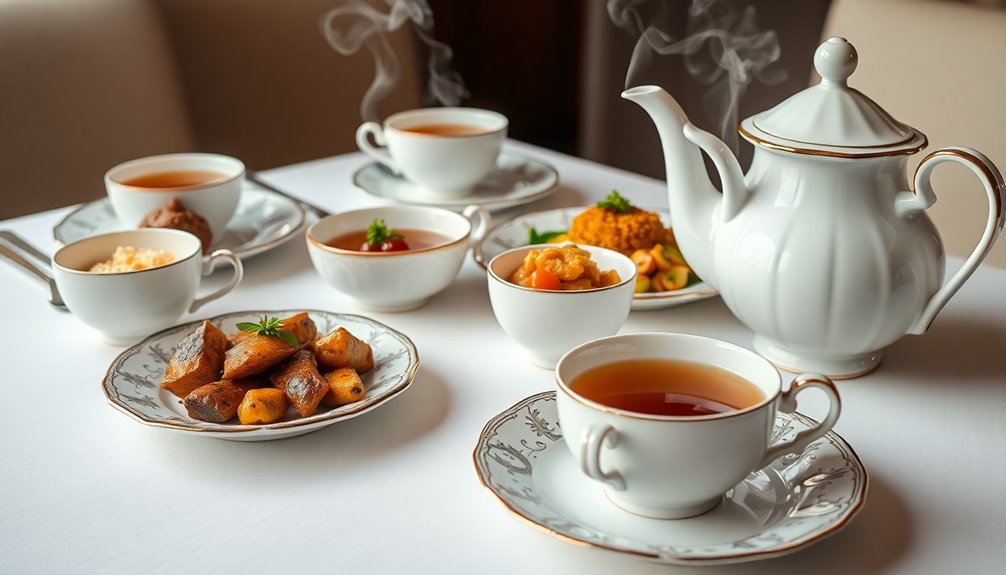
Finding the right tea to complement your savory dishes can elevate your dining experience significantly. Start by considering the flavor intensity of both your tea and food. For lighter dishes like salads, opt for delicate white tea, which enhances the freshness without overpowering. Additionally, pairing your tea with food can also offer health benefits, such as aiding digestion and promoting overall well-being. Incorporating teas into your meals can be a way to diversify crypto assets within your investment strategy. Interestingly, certain types of honey, such as Turkish honey, can also enhance digestion when consumed with meals.
If you're serving hearty meals like lasagna, robust black teas, such as Assam, will provide a bold contrast that enriches the overall taste. Don't overlook oolong teas; they can enhance the umami flavors in savory fish or grilled meats, neutralizing oiliness and balancing richness. For creamy soups, a strong black tea can work wonders, making each bite more enjoyable.
Experiment with herbal teas too, like rooibos, which pairs excellently with chicken and blue cheese, adding a unique flavor profile to your savory dishes. And if you're feeling adventurous, try incorporating regional varieties—like pairing jasmine green tea with curried chicken—to explore traditional flavor combinations that can elevate your meals further.
Lastly, don't forget about smoky lapsang souchong; this distinctive tea can add depth to various savory dishes, creating a memorable dining experience. Additionally, consider that certain teas can also offer health benefits, such as improving metabolism and digestion, which can be particularly advantageous when enjoying rich meals.
Conclusion
Incorporating tea into your savory dishes can elevate your meals in unexpected ways. By understanding how tea enhances umami flavors and balancing them with the right pairings, you can transform your dining experience. Remember to explore cultural differences in tea pairings for even more inspiration. So go ahead, experiment with different teas alongside your favorite savory dishes, and discover the delightful harmony that awaits! Your taste buds will thank you for it.

